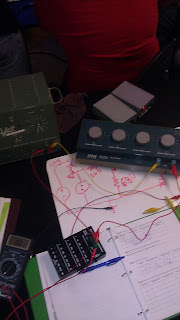First we calculate Vth which is equal to Vx
then we Calculate the following,
Vy=5.11V
Vy/Rc3=Isc
Rth=Voc/Isc
Rth=65.98ohms
1.
then we find the smallest permissible RL2 using a voltage divider which is
Vth/(Rth+RL2)*RL2=VL2
VL2=8V
RL2=819.9ohms
2.
The short circuit current is then found by
8/819.9=.0098A
3.
The open circuit voltage is found to be
8.64V
then we set up the experiment
and come up with the following values
| Component | Nominal Value | Measured Value |
| Rth | 66Ω | 65.9Ω |
| Rl2,min | 819.9Ω | 820Ω |
| Vth | 8.64V | 8.66V |
| Config | Theoretical Value | Measured Value | % Error |
| Rl2=Rl2,min | Vload2=8V | 7.78V | 2.75% |
| Rl2=infiniteΩ | Vload2=8.64V | 8.71V | 1.00% |
| Component | Nominal Value | Measured Value |
| Rc1 | 100 | 98 |
| Rc2 | 39 | 38 |
| Rc3 | 39 | 39 |
| RL1 | 680 | 667 |
| Vs1 | 9 | 9.1 |
| Vs2 | 9 | 9.18 |
| Config | Theoretical Value | Measured Value |
| Rl2=Rl2,min | Vload2=8V | 6.9 |
| Rl2=infiniteΩ | Vload2=8.64V | 7.94 |
| Configuration | Vload2 |
| RL2=0.5Rth | 1.8 |
| RL2=Rth | 2.85 |
| RL2=2Rth | 4.16 |
in conclusion we have found that by calculating the Thevenin Equivalents we can easily find new values for V and R thevenin when sources or resistors are added to the circuit.


No comments:
Post a Comment